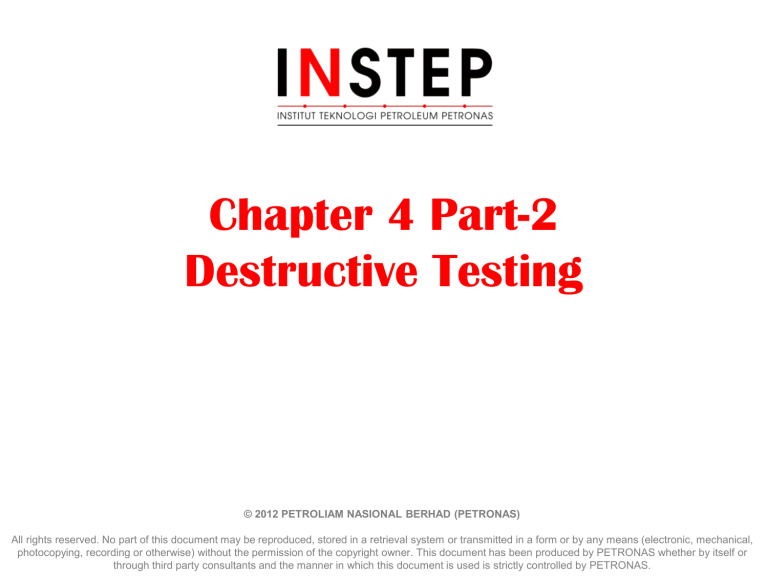
Chapter 4 Part-2 Destructive Testing © 2012 PETROLIAM NASIONAL BERHAD (PETRONAS) All rights reserved. No part of this document may be reproduced, stored in a retrieval system or transmitted in a form or by any means (electronic, mechanical, photocopying, recording or otherwise) without the permission of the copyright owner. This document has been produced by PETRONAS whether by itself or through third party consultants and the manner in which this document is used is strictly controlled by PETRONAS. Destructive Testing (DT) Mechanical tests performed on a sample resulting in the sample’s destruction. •Several types of DT: Tensile Testing Fatigue Testing Shear Strength Testing Weld Testing Welded Butt Joints Fillet Weld Break Test Etching Impact Testing Hardness Test • Rockwell • Knoop & Vickers © 2012 PETROLIAM NASIONAL BERHAD (PETRONAS) Tensile Testing •Tensile test is to determine the modulus of elasticity, elastic limit, elongation, proportional limit, reduction in area, tensile strength, yield point, yield strength and other tensile properties • The result is expressed by the plot of load versus elongation curve. When it is converted into a stress versus strain curve, the same shape as the engineering stress -strain curve is obtained. •The stress-strain curve relates the applied stress to the resulting strain and each material has its own unique stressstrain curve - it is found that the stressstrain curve increases continuously up to fracture. © 2012 PETROLIAM NASIONAL BERHAD (PETRONAS) Tensile Test • Universal testing/tensile tester • Specimen: cylindrical rods or flat plates. (refer to ASTM standards) • According to standard ASTM E8 or D638 the purpose of reducing the cross sectional area / diameter of the specimen throughout the “gauge length”: - - To avoid having a break or fracture within the area being gripped on the specimen To ensure the break will occur in the "gauge length" © 2012 PETROLIAM NASIONAL BERHAD (PETRONAS) Universal Testing Machine © 2012 PETROLIAM NASIONAL BERHAD (PETRONAS) Accessories in Universal Testing Machine EXTENSOMETER LASER EXTENSOMETER © 2012 PETROLIAM NASIONAL BERHAD (PETRONAS) List of ASTM standard test for Tensile Test ASTM TEST DESCRIPTION A 370 Standard methods for steel products B 208 Cast Copper Alloys B 557 Cast Aluminum and magnesium alloys E 338 Sharp-notch, high strength sheet materials D 638 Plastics E 345 Metallic foil D 3039 Resin-matrix composites E 517 Plastic Strain ratio for sheet metal D 3379 High-modulus single-filament materials E 607 Sharp-notch, cylindrical specimens E 646 Tensile strain-hardening exponents E8 Tension testing of metallic materials F 606 Fasteners E 21 Elevated-temperature tests, metallic materials E 292 Time for rupture, notch tension E 329 Concrete, steel, and bituminous materials ASTM TEST DESCRIPTION © 2012 PETROLIAM NASIONAL BERHAD (PETRONAS) Tensile Test Procedure 1. 2. Mount test sample on the machine using grippers Force transducer connected to gripper, measures the applied force during test 3. Extensometer clamps the specimen body to convert length change to an electrical measurement 4. During the test, crosshead is moved to create a tensile force in the test sample 5. The force is measured by the force transducer (a special device that converts force into an electrical measurement) and the tensile stress is calculated by dividing force to the original cross sectional area. 6. The length of the reduced section is measured by extensometer. 7. The strain is calculated by dividing the change in length to original length. 8. Once the samples fractures, it is removed from the tensile testing machine , final length and area are measured and ductility can be calculated. © 2012 PETROLIAM NASIONAL BERHAD (PETRONAS) Tensile Test Stages • • • • • • • • • • Early stage, specimen behaves elastically If crosshead stopped and go to original position, sample will return to original length As the test continues the stress in the specimen increases and the length within the gage region becomes longer The stress strain curve is approximately linear and the slope of that curve is the elastic modulus. As the stress continue to increase, sample continue to elongate until reaches a point – permanent plastic deformation occurs (elastic limit, yield point) The cross sectional area reduced, length increased Continues to pull the sample, the material harden and get stronger, A rapidly decreased, reducing load carrying capacity. The curve reach a peak (UTS) and begin to drop. Reduction in cross sectional area, localized spot (necking) Fracture into two halves © 2012 PETROLIAM NASIONAL BERHAD (PETRONAS) Fatigue Testing • Fatigue crack- results from cyclic stresses that are below the ultimate tensile stress • Fatigue life - the number of loading cycles required to initiate a fatigue crack & to propagate the crack to critical size • Behavior of materials under cyclic load differs from static load - predict fatigue life • Control system will control the test and measure data at high frequencies specimen load, and compensate for load errors induced by the dynamic movement © 2012 PETROLIAM NASIONAL BERHAD (PETRONAS) 10 Shear Strength Testing • Shear test can be performed in a tensile machine, with special grips replacing the tensile test gripper. • The ability of a metal to withstand a cutting force or offset loads. Example of component having good shear strength properties are bolts, rivets, drive key which are used in construction. • Shear strength : stress at which a shearload member will fail. Based on distortion energy theory, shear yield strength is 57.7% of the tensile yield strength. • Two forms of shearing strength of the welds: – transverse shearing strength - longitudinal shearing strength © 2012 PETROLIAM NASIONAL BERHAD (PETRONAS) 11 Weld Testing 3 types of weld tests are: Welded Butt Joints Fillet Weld Break Test Etching test Welded Butt Joint can be tested by 3 methods: Nick-Break Test Guided Bend Test groove butt joints ≤ 3/8 in (10mm) – face & root bend If pass, groove welds on plate 3/8 in to ¾ in ( 10-19mm), machined If pass, can make fillet weld of unlimited thickness Groove butt joins 1 in. (25mm) – side bend © 2012 PETROLIAM NASIONAL BERHAD (PETRONAS) Free bend Test – welded joins in plate 12 Impact Test An impact test - determine the energy absorbed in fracturing a test piece at high velocity . Specimen is broken by a single overload event due to the impact of the pendulum- Izod test & Charpy test. Both use different specimens and methods of holding the specimens Impact toughness – take note the height pendulum is released & the height to which the pendulum swings back Height x weight of the pendulum = potential energy Difference in potential energy at the start & end is equal to the absorbed energy Impact strength can be affected by temperature especially for carbon steel © 2012 PETROLIAM NASIONAL BERHAD (PETRONAS) Hardness Test Hardness is the resistance of a material to permanent indentation. Hardness test consists of pushing a penetrator into the material and measuring the effect. There are four major hardness scales: Brinell - HB Knoop - HK Rockwell - HR Vickers - HV Each of these scales involve the use of a specifically shaped diamond, carbide or hardened steel indenter pressed into the material with a known force using a defined test procedure. The hardness values are determined by measuring either the depth of indenter penetration or the size of the resultant indent. The hardness values are reported using the proper symbol, HR, HV, HK, etc. indicating the test scale performed. © 2012 PETROLIAM NASIONAL BERHAD (PETRONAS) Brinell - HB • The Brinell test is frequently used to determine the hardness metal forgings and castings that have a large grain structures. • The only hardness test that is considered as NDT. • Nearly all metals can be tested using a Brinell test • The Brinell number is obtained by dividing the load used (kg) by the measured surface area of the indentation (mm2) • • • Iron and steel castings : 3000Kg test force and a 10mm diameter ball Aluminum castings : 1500 kg test force and a 10mm diameter ball Copper, brass : 500Kg test force and a 10 or 5mm ball. © 2012 PETROLIAM NASIONAL BERHAD (PETRONAS) Rockwell - HR There are two types of Rockwell tests: Rockwell: the minor load is 10 kgf, the major load is 60, 100, or 150 kgf. Superficial Rockwell: the minor load is 3 kgf and major loads are 15, 30, or 45 kgf. In both tests, the indenter may either be a steel ball of some specified diameter or a spherical diamond-tipped cone of 120° angle and 0.2 mm tip radius, called a brale © 2012 PETROLIAM NASIONAL BERHAD (PETRONAS) Vickers - HV • The Vickers test has two distinct force ranges, micro (10g to 1000g) and macro (1kg to 100kg), to cover all testing requirements • All Vickers ranges use a 136° pyramidal diamond indenter that forms a square indent. © 2012 PETROLIAM NASIONAL BERHAD (PETRONAS) Knoop - HK • Knoop tests are mainly done at test forces from 10g to 1000g, so a high powered microscope is necessary to measure the indent size. Because of this, Knoop tests have mainly been known as micro hardness tests. • The indenter used is a rhombic-based pyramidal diamond that produces an elongated diamond shaped indent © 2012 PETROLIAM NASIONAL BERHAD (PETRONAS) © 2012 PETROLIAM NASIONAL BERHAD (PETRONAS)


